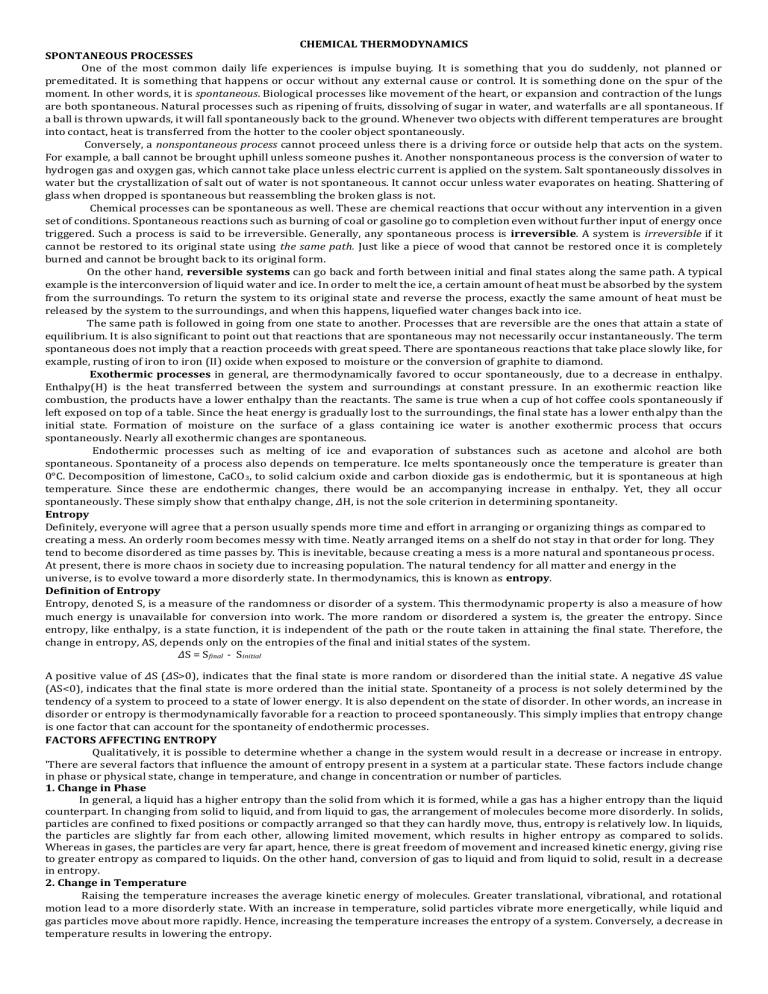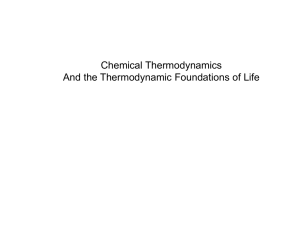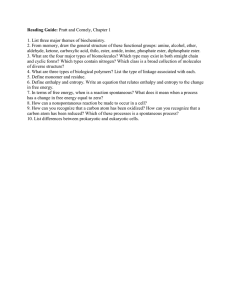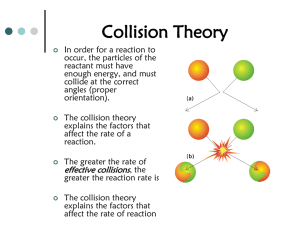
CHEMICAL THERMODYNAMICS SPONTANEOUS PROCESSES One of the most common daily life experiences is impulse buying. It is something that you do suddenly, not planned or premeditated. It is something that happens or occur without any external cause or control. It is something done on the spur of the moment. In other words, it is spontaneous. Biological processes like movement of the heart, or expansion and contraction of the lungs are both spontaneous. Natural processes such as ripening of fruits, dissolving of sugar in water, and waterfalls are all spontaneous. If a ball is thrown upwards, it will fall spontaneously back to the ground. Whenever two objects with different temperatures are brought into contact, heat is transferred from the hotter to the cooler object spontaneously. Conversely, a nonspontaneous process cannot proceed unless there is a driving force or outside help that acts on the system. For example, a ball cannot be brought uphill unless someone pushes it. Another nonspontaneous process is the conversion of water to hydrogen gas and oxygen gas, which cannot take place unless electric current is applied on the system. Salt spontaneously dissolves in water but the crystallization of salt out of water is not spontaneous. It cannot occur unless water evaporates on heating. Shattering of glass when dropped is spontaneous but reassembling the broken glass is not. Chemical processes can be spontaneous as well. These are chemical reactions that occur without any intervention in a given set of conditions. Spontaneous reactions such as burning of coal or gasoline go to completion even without further input of energy once triggered. Such a process is said to be irreversible. Generally, any spontaneous process is irreversible. A system is irreversible if it cannot be restored to its original state using the same path. Just like a piece of wood that cannot be restored once it is completely burned and cannot be brought back to its original form. On the other hand, reversible systems can go back and forth between initial and final states along the same path. A typical example is the interconversion of liquid water and ice. In order to melt the ice, a certain amount of heat must be absorbed by the system from the surroundings. To return the system to its original state and reverse the process, exactly the same amount of heat must be released by the system to the surroundings, and when this happens, liquefied water changes back into ice. The same path is followed in going from one state to another. Processes that are reversible are the ones that attain a state of equilibrium. It is also significant to point out that reactions that are spontaneous may not necessarily occur instantaneously. The term spontaneous does not imply that a reaction proceeds with great speed. There are spontaneous reactions that take place slowly like, for example, rusting of iron to iron (II) oxide when exposed to moisture or the conversion of graphite to diamond. Exothermic processes in general, are thermodynamically favored to occur spontaneously, due to a decrease in enthalpy. Enthalpy(H) is the heat transferred between the system and surroundings at constant pressure. In an exothermic reaction like combustion, the products have a lower enthalpy than the reactants. The same is true when a cup of hot coffee cools spontaneously if left exposed on top of a table. Since the heat energy is gradually lost to the surroundings, the final state has a lower enthalpy than the initial state. Formation of moisture on the surface of a glass containing ice water is another exothermic process that occurs spontaneously. Nearly all exothermic changes are spontaneous. Endothermic processes such as melting of ice and evaporation of substances such as acetone and alcohol are both spontaneous. Spontaneity of a process also depends on temperature. Ice melts spontaneously once the temperature is greater than 0°C. Decomposition of limestone, CaCO3, to solid calcium oxide and carbon dioxide gas is endothermic, but it is spontaneous at high temperature. Since these are endothermic changes, there would be an accompanying increase in enthalpy. Yet, they all occur spontaneously. These simply show that enthalpy change, 𝛥H, is not the sole criterion in determining spontaneity. Entropy Definitely, everyone will agree that a person usually spends more time and effort in arranging or organizing things as compared to creating a mess. An orderly room becomes messy with time. Neatly arranged items on a shelf do not stay in that order for long. They tend to become disordered as time passes by. This is inevitable, because creating a mess is a more natural and spontaneous process. At present, there is more chaos in society due to increasing population. The natural tendency for all matter and energy in the universe, is to evolve toward a more disorderly state. In thermodynamics, this is known as entropy. Definition of Entropy Entropy, denoted S, is a measure of the randomness or disorder of a system. This thermodynamic property is also a measure of how much energy is unavailable for conversion into work. The more random or disordered a system is, the greater the entropy. Since entropy, like enthalpy, is a state function, it is independent of the path or the route taken in attaining the final state. Therefore, the change in entropy, AS, depends only on the entropies of the final and initial states of the system. 𝛥S = Sfinal - Sinitial A positive value of 𝛥S (𝛥S>0), indicates that the final state is more random or disordered than the initial state. A negative 𝛥S value (AS<0), indicates that the final state is more ordered than the initial state. Spontaneity of a process is not solely determined by the tendency of a system to proceed to a state of lower energy. It is also dependent on the state of disorder. In other words, an increase in disorder or entropy is thermodynamically favorable for a reaction to proceed spontaneously. This simply implies that entropy change is one factor that can account for the spontaneity of endothermic processes. FACTORS AFFECTING ENTROPY Qualitatively, it is possible to determine whether a change in the system would result in a decrease or increase in entropy. 'There are several factors that influence the amount of entropy present in a system at a particular state. These factors include change in phase or physical state, change in temperature, and change in concentration or number of particles. 1. Change in Phase In general, a liquid has a higher entropy than the solid from which it is formed, while a gas has a higher entropy than the liquid counterpart. In changing from solid to liquid, and from liquid to gas, the arrangement of molecules become more disorderly. In solids, particles are confined to fixed positions or compactly arranged so that they can hardly move, thus, entropy is relatively low. In liquids, the particles are slightly far from each other, allowing limited movement, which results in higher entropy as compared to solids. Whereas in gases, the particles are very far apart, hence, there is great freedom of movement and increased kinetic energy, giving rise to greater entropy as compared to liquids. On the other hand, conversion of gas to liquid and from liquid to solid, result in a decrease in entropy. 2. Change in Temperature Raising the temperature increases the average kinetic energy of molecules. Greater translational, vibrational, and rotational motion lead to a more disorderly state. With an increase in temperature, solid particles vibrate more energetically, while liquid and gas particles move about more rapidly. Hence, increasing the temperature increases the entropy of a system. Conversely, a decrease in temperature results in lowering the entropy. 3. Number of Particles The phrase "the more, the merrier" can certainly be applied to entropy. It is definitely "merrier" when there are more people in a gathering. When a lot of people are present, there will be more movement, more noise, more wastes, and definitely, greater disorder. This means greater entropy. A party with 50 invited guests is definitely merrier but more chaotic than a party with only five people. A big family has a higher entropy than a small family. Consider a chemical system represented by the following equation, A2B 2A + B At the left of the arrow, only one particle is present as reactant, but at the right side, a total of three particles are produced from the reaction. Since there are more particles in the products as compared to the reactants, there is a corresponding increase in disorder. Generally, an increase in the number of particles, increases in entropy. THE SECOND LAW OF THERMODYNAMICS Processes in which disorder increases are favored to occur spontaneously. This is the basis of the second law of thermodynamics in predicting the spontaneity of a process. The law expresses the relationship between spontaneity and entropy. It states that natural processes proceed in the direction that maintains or increases the total entropy of the universe, and in any spontaneous change, there is a net increase in entropy. Since the universe consists of two parts, the system and the surroundings, it makes the entropy change of the universe is the sum of the changes in entropy of the system and the surroundings as expressed by the following situation: 𝛥Suniverse= 𝛥Ssystem + 𝛥Ssurroundings Under standard conditions, the entropy change for the universe, 𝛥SOuniverse is 𝛥Suniverse= 𝛥Ssystem + 𝛥Ssurroundings 𝛥Suniverse > 0 for spontaneous process SIGNIFICANCE OF THE SECOND LAW The second law of thermodynamics is one of the most powerful tools that helps explain everything that happens in the physical world. It enables us to understand why things work as they do, why gasoline makes the engine run, why hot pots cool down, or why our bodies stay warm even when it is cooled. In industry or engineering, the second law can help determine which reaction will favor the formation of desired products to obtain better economical yields. When changes occur, there comes a time when no further change appears to take place. A ball rolling down a hill stops either at the foot of the hill or a little farther, the moment it has lost all its excess energy. At this point, the ball comes to a state of rest and all opposing forces acting on the ball balance each other. The system is said to attain a state of static equilibrium. When a hot metal with a temperature of around 100°C is dropped into water at 30°C, heat is transferred from the metal to water. After sometime, the temperature of both the metal and water will be the same. A hot flat iron once unplugged, starts to cool. Heat flows from the flat iron to the surroundings. When it reaches room temperature, it stops cooling. In both instances, the system attains thermal equilibrium. Another example is a can of carbonated drink. Within the sealed can, equilibrium exists between the carbon dioxide gas dissolved in the drink and the undissolved carbon dioxide. Provided the can is not opened and temperature is kept constant, the concentration of carbon dioxide remains the same. Similarly, evaporation and condensation processes can also occur simultaneously at the same rate, so that no change in the amount of water is observed. These examples involve physical equilibrium. The concept of chemical equilibrium explains several natural phenomena and plays an important role in determining how conditions should be altered to hasten desirable reactions, minimize undesirable products, and obtain better economic yield for industrial Figure 1.Equilibrium state: rate of processes. evaporation = rate of condensation The Equilibrium Condition In the chemistry laboratory, there are instances when reactions being observed like precipitation, evolution of gas, or changes in color appear to stop. Most chemical reactions seem to have gone to completion, that is, all the reactants appear to have been converted into products. The reaction 2Na + Cl2 2NaCl, occurs in one direction only and it will stop the moment one of the reactants is used up. Normally, none of the NaCl produced will dissociate back to chlorine gas and sodium. This reaction is said to go to completion. Reactions where the products cannot form back to the reactants under the same conditions that permit the latter to produce the former is said to be irreversible. Reversible reaction is a type of chemical reaction wherein two opposing processes occur simultaneously is said to be reversible. The reaction does not go to completion. The double arrows (⇌) indicate that the reaction is reversible. Reactions that are reversible attain a state of chemical equilibrium. Experiments show that complete conversion of reactant to products does not really occur in most chemical reactions. This is because as soon as enough products are produced, they begin to react with each other to reform the reactants. Just as the reactants interact to form the products in the forward direction, the products also interact to form back the reactants in the opposite or reverse direction. If the components of a reversible reactions are kept together in a sealed container, there Figure 2.This reaction is in comes a time when there is no more net change in the amounts of reactants and products present in dynamic equilibrium because the reaction mixture. This indicates that the reaction has reached a state of chemical equilibrium, in products are being converted to which the forward and reverse reactions are occurring at the same rate. The condition is described reactants and reactants are as dynamic equilibrium since the two opposing reactions are still taking place, except that the being converted to products. reactants are replenished just as fast as they are consumed, thus keeping the concentration constant.









